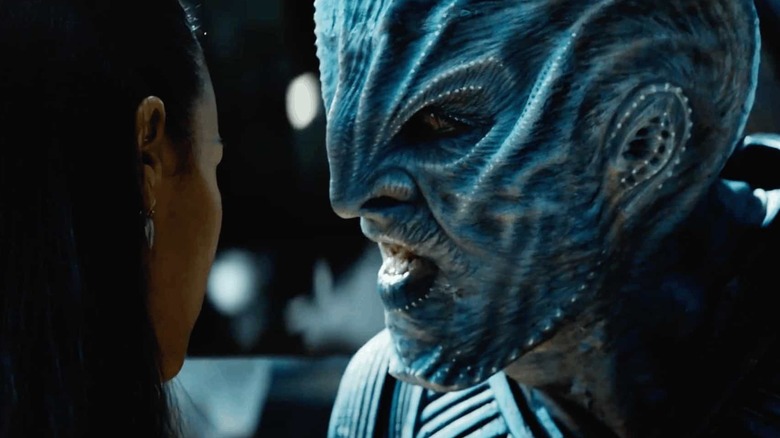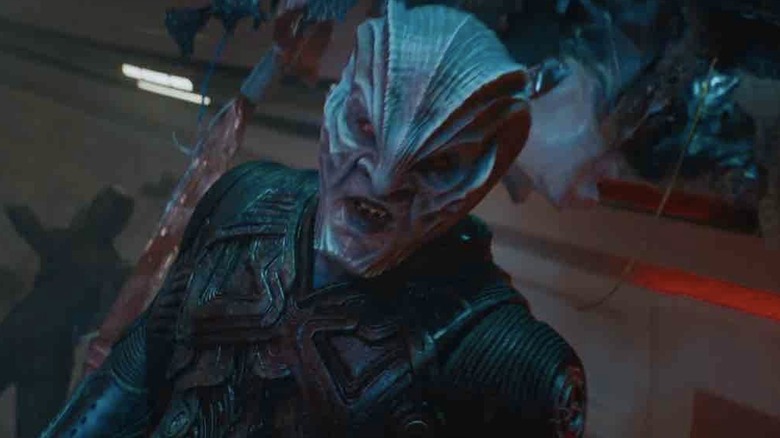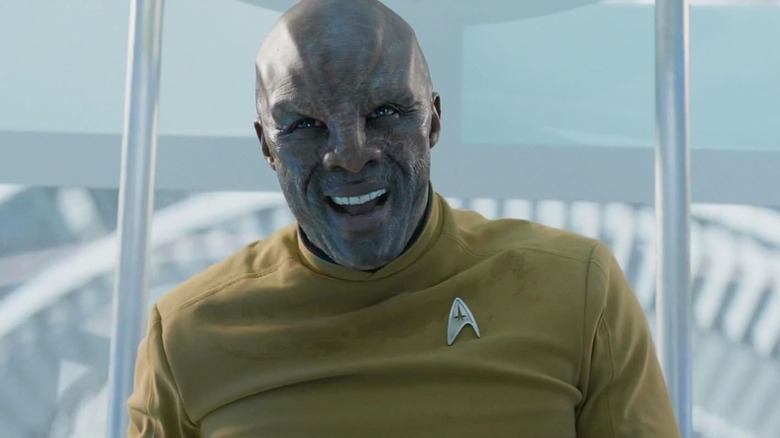Krall's Bizarre Vampire Powers In Star Trek Beyond Explained
Justin Lin's 2016 film "Star Trek Beyond" came at a strange juncture in "Star Trek" history. Paramount had two enormously successful "Star Trek" films in 2009 and 2013, both taking the ordinarily talky and contemplative franchise into a quicker, more violent, action-packed direction. Audiences flocked to those movies, both helmed by J.J. Abrams, enjoying the fact that "Star Trek" now more closely resembled "Star Wars." One year before "Beyond" was released, however, the Disney-backed Lucasfilm released "Star Wars: The Force Awakens," the first "Star Wars" theatrical feature film since 2008. "The Force Awakens" was a massive success, and the public's itch for space action was now being satisfyingly scratched. It, too, was helmed by J.J. Abrams.
With real "Star Wars" back in the public eye, audiences no longer needed the supposed "fake 'Star Wars'" action that the new Trek films provided. "Beyond," as a result, was not as massive a hit as its forebears, and Paramount put the kibosh on further entries. Note: we may still get a fourth "Star Trek" film in the Kelvin continuity, but I'll believe that when I see it.
In all three of the Kelvin movies, the story revolves around a passionately evil villain who sought revenge. For "Beyond," the villain was Krall (Idris Elba), a strange alien monster with access to millions of destructive space drones, and a device that allows him to "vampire" life energy out of people. He crash-landed on the planet Altamid a century ago and spent the ensuing time salvaging ancient Altamid technology and scheming against the Federation.
Krall's "DNA vampire" powers aren't well explained in "Beyond," so co-writer Doug Jung talked to Trek Core in 2016 to clarify a few things.
Balthazar Edison
Late in the film, it will be revealed that Krall was actually once a human named Balthazar Edison, a Starfleet officer who served on board a starship called the U.S.S. Franklin. Edison was able to stay alive on Altamid thanks to the DNA vampire technology which prolonged his life but also caused him to mutate. Edison has been alive long enough to remember the days before the Federation — his ship and uniform are from the era of "Star Trek: Enterprise" — and he resented that the Federation made peace with previously violent enemies like the Xindi. For years, he's been searching for a destructive relic that he could as a biological weapon to kill millions and wipe out the Federation.
When Krall uses his vampire technology to siphon the life out of captured Starfleet officers, his mutations begin to correct themselves. Throughout the film, he looks more and more human. Jung said that the "Beyond" makeup team had to design the un-mutation carefully, so as not to reveal to audiences too soon that Krall was actually a human. He said:
"We had a lot of different versions. We hinted at it a lot more at one point. We talked about it more at one point. And then ultimately we just sort of decided that we needed it to be part of the whole reveal package. It's a complex idea, if you really think about what he had to do and how he had to get there. [...] [T]here was actually another phase that we took out, where Krall became too human-looking, and you would have connected the dots a little more."
No one, Jung said, was able to guess Krall and the crashed NX starship were connected. He was proud of that.
Krall's timeline
The film explains that the local technology on Altamid physically transformed Balthazar Edison into a non-human species, but why does he use the name Krall, and why doesn't he speak any human languages when audiences first see him? That will require a little delving into the timeline of events in the broader "Star Trek" chronology. Edison, recall, was commanding a ship that resembled the Enterprise from "Star Trek: Enterprise," and his uniform matched that series as well, making his life contemporary with Captain Jonathan Archer (Scott Bakula).
"Enterprise" takes place in the 2150s, and by Trek's history, the Federation was formed in 2161, after the Xindi War that destroyed the state of Florida and killed millions. That means the U.S.S. Franklin flew through a wormhole, post-Xindi conflict, and crashed on Altamid in the mid-2160s. "Star Trek Beyond," incidentally, takes place in 2263.
Altamid was uninhabited when Edison crashed, only occupied by abandoned technology. Edison, as well as a pair of surviving crewmates, would lure passing alien ships to their planet, drag them down to the surface with killer drones, and use an infernal machine to absorb the DNA of the survivors. Edison so hated the Federation's gentle humanity that he deliberately abandoned being human. He turned into an alien, changed his name, and deliberately stopped using human language.
Krall sustained himself, vampire style, for 100 years before attacking the new U.S.S. Enterprise, captained by James T. Kirk (Chris Pine). Because Kirk's Enterprise was populated by many humans, Krall vampired human DNA back into his system, and he began to change back.
All the above exposition is given in "Star Trek Beyond," however in a non-explicit fashion. Krall is still a revenge villain, but his backstory is good for a Kelvin movie.


